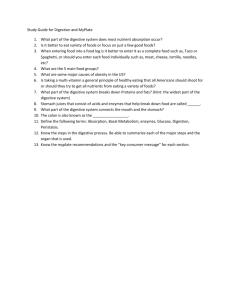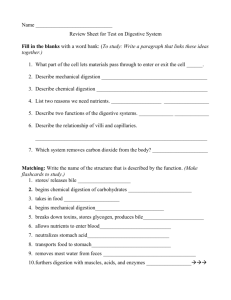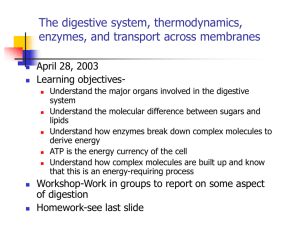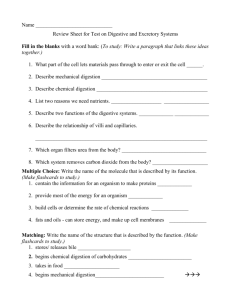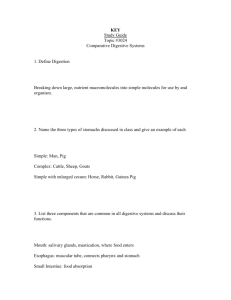Digestive System Webquest
advertisement
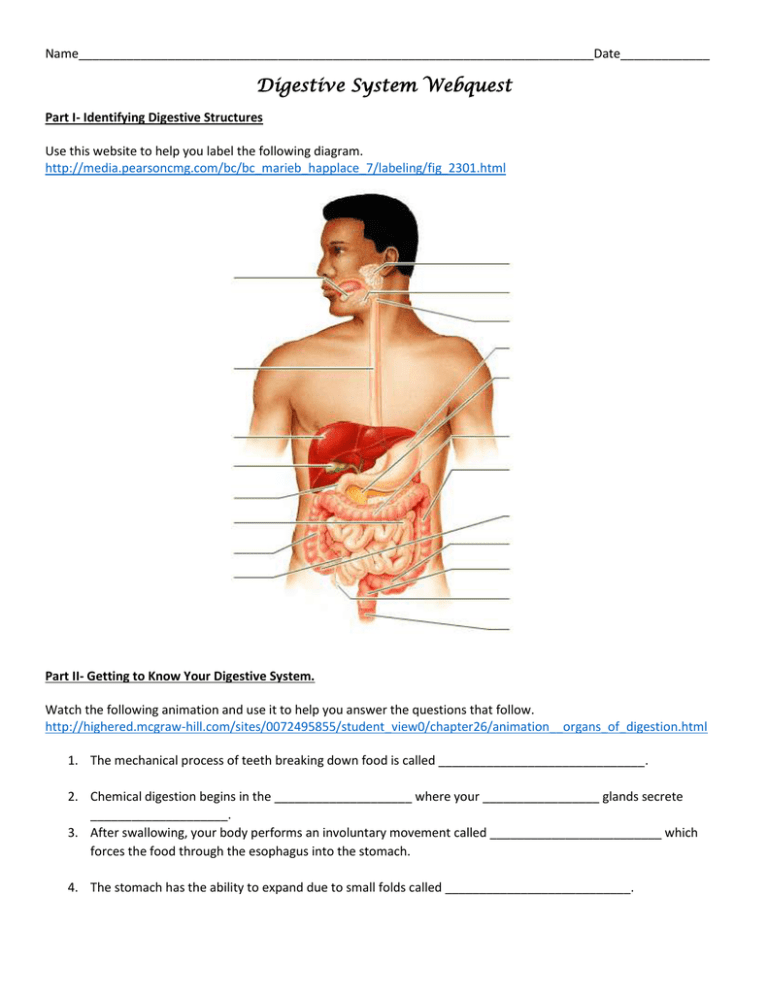
Name___________________________________________________________________________Date_____________ Digestive System Webquest Part I- Identifying Digestive Structures Use this website to help you label the following diagram. http://media.pearsoncmg.com/bc/bc_marieb_happlace_7/labeling/fig_2301.html Part II- Getting to Know Your Digestive System. Watch the following animation and use it to help you answer the questions that follow. http://highered.mcgraw-hill.com/sites/0072495855/student_view0/chapter26/animation__organs_of_digestion.html 1. The mechanical process of teeth breaking down food is called ______________________________. 2. Chemical digestion begins in the ____________________ where your _________________ glands secrete ____________________. 3. After swallowing, your body performs an involuntary movement called _________________________ which forces the food through the esophagus into the stomach. 4. The stomach has the ability to expand due to small folds called ___________________________. 5. The stomach aids in digestion by secreting a strong acid called _______________________________. 6. The bolus, mixed with stomach juices, is now called _____________________________. 7. Once food exits the stomach through the ______________________sphincter, it enters the first part of the small intestines called the _______________________. 8. The chyme then flows through the rest of the small intestine, consisting of the ________________________ and _________________________. 9. The liver and pancreas are considered to be secondary digestive structures. What roles do they play in digestion? 10. Anything that isn’t digested in the small intestine is passed into the large intestine where ________________________ and _____________________ are absorbed and the remaining chyme becomes __________________. 11. What is the role of the rectum? *Check your knowledge* See if you can answer the questions for this small quiz based on what you have just learned! Try not to look back at your previous answers! Part III- Digestive Enzymes Read the information from the following website to help you answer the questions. http://www.sciencelearn.org.nz/Contexts/Digestion-Chemistry/Looking-Closer/Digestive-enzymes 1. Most enzymes are named using the suffix _________ 2. How else are enzymes named? 3. Enzymes are part of what group of macromolecule? __________________ 4. The substance that the enzyme connects with is called the _________________________ 5. Name 2 substances that could possibly bind to the active site and therefore poison you __________________ & ____________________ 6. What class of enzymes do digestive enzymes belong to and what is their function? 7. Name the 5 major enzyme producing structures of the digestive system. a. __________________________ b. __________________________ c. __________________________ d. __________________________ e. __________________________ Read the following article to learn specifics about the enzymes necessary to digest your food and then fill in the chart. http://healthyeating.sfgate.com/functions-amylase-protease-lipase-digestive-enzymes-3325.html Enzyme Category Amylases Proteases - Pepsin - Trypsin - Chymotripsin Lipases Other Digestive Enzymes: Where it’s produced What it breaks down Where digestion occurs Part IV- Gastrointestinal Diseases A. The new fad of going “gluten-free” has swept the country. More and more people are going on gluten-free diets and more and more companies are coming out with gluten-free products. Read the following article to educate yourself about why people choose to be gluten-free and who is really effected by gluten! Answer the questions that follow. http://health.usnews.com/health-news/articles/2012/06/01/making-sense-of-the-gluten-free-food-frenzy 1. What is gluten? Did you know that most people who are gluten free do not even know what gluten is? Just watch this clip from Jimmy Kimmel! http://www.refinery29.com/2014/05/67578/jimmy-kimmel-gluten 2. Who SHOULDN’T eat gluten, and why? 3. Most people who should not eat gluten suffer from a disease called ____________________disease. Only about ____% of the population actually suffers from this disease! However, about _________% of the population suffers from gluten sensitivity. So if you have gastrointestinal issues they suggest you try being gluten-free for about a week to see if it helps. 4. Why is gluten all of a sudden an issue? Why didn’t our grandparents deal with this way back when they were wee lads? 5. Why are many doctors against a gluten-free diet? B. IBS (irritable bowel syndrome) was once thought to be a psychological disorder. Read this article to find out about the truth! http://www.medicalnewstoday.com/releases/273833.php and answer the questions. 1. What is IBS? What causes it? 2. How can nutrition effect this disease? 3. What can you do to improve symptoms? C. Research 1 other gastrointestinal disease of your choice. Explain what it is, symptoms, what causes it, and how you can improve the symptoms. Part V- Nutrition Before you begin this section, calculate your BMI (Body Mass Index) by using this online BMI calculator http://nutritiondata.self.com/tools/calories-burned 1. What is your BMI? _________________ 2. How many calories must you intake to maintain your BMI?________________ 3. Fill out the following chart to try to figure out approximately how many calories you ate yesterday. Use google to help you look up calories. Meal Breakfast Food Items Approximate Calories Calorie type in grams CPF- Lunch CPF- Dinner CPF- Snacks/Beverages CPF- Total Calorie intake yesterday _______________ 4. Was your calorie intake more or less than what your BMI requires? 5. Look at your recommended macronutrient percentages for carbs, fats, and proteins. List them here Carbs ____________ Protein_______________ Fat_____________ 6. Compare your numbers from the previous question to your chart totals. Do you eat too much or too little of any of them? Which ones? 7. If your BMI is higher than the average, what could you do to your diet to live a healthier lifestyle? 8. What could you do to decrease your BMI without changing your calorie consumption?

